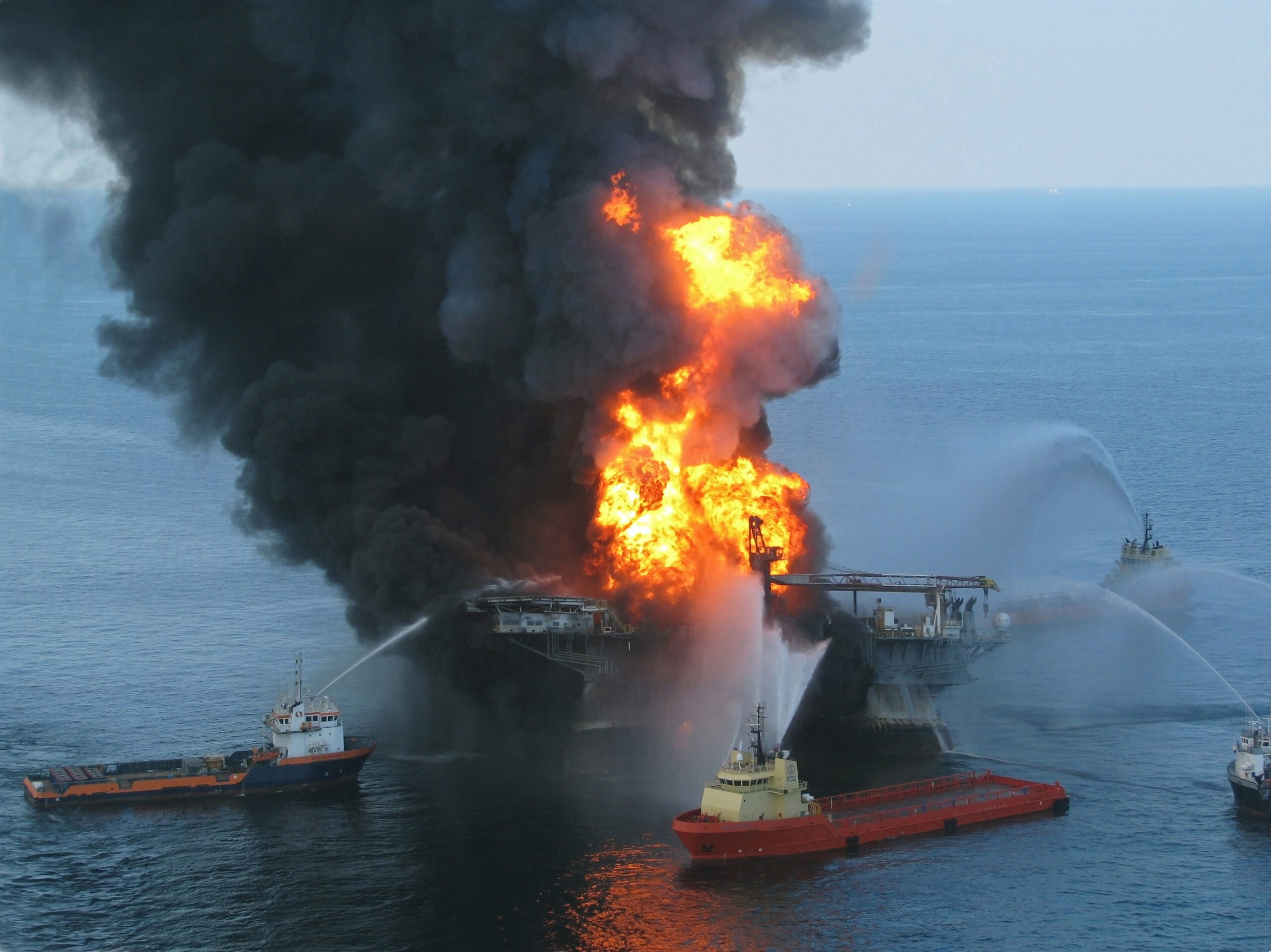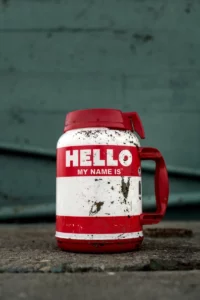The Deepwater Horizon disaster of 2010 was one of the worst environmental disasters in American history. A series of engineering blunders caused an explosion that ultimately sank the Deepwater Horizon, killing eleven crew members in the process. The world watched anxiously as an estimated 53,000 barrels of oil gushed from the Macondo well until it was finally capped several months later. The Gulf States, still reeling from the massive destruction of Hurricane Katrina in 2005, suffered another enormous setback, as thousands of miles of coastline were covered in crude oil. This led to an unprecedented economic disturbance as thousands of workers in maritime-related industries were forced out of work. Years later, cleanup efforts are still a work in progress, economic and civil penalties have been assessed, and the legal effects from the disaster are just beginning to take hold.
On April 20, 2010, just forty one miles off the coast of Louisiana, an explosion rocked the Deepwater Horizon rig, killing eleven crew members and injuring several others. Two days later, it sank to the bottom of the Gulf of Mexico, leaving behind a continuous stream of oil flowing at the sea floor.[1] This event marked the beginning of one of the worst environmental disasters in the history of the United States, as millions of barrels continued to gush from the Macondo well until it was finally capped on July 15, 2010.[2] The effects of the Deepwater’s demise are still being investigated to this day. BP has estimated that its total costs from this disaster will equal nearly forty billion dollars.[3] The impact of this disaster cannot be understated, as it has had a tremendous impact on the environment of the Gulf of Mexico, as well as its economy. The human cost of the spill, including lost wages, unemployment, and economic hardship have also been catastrophic. There is a legal patchwork of federal and state law pertaining to maritime oil spills, which often creates an interesting dynamic as victims of the spill attempt to gain compensation for their economic hardships. This research paper will examine the intricacies of United States maritime tort law with regard to maritime oil spills, as well as the dynamic interplay of federal civil and criminal law. Further, it will delve into the policy arguments relating to having a capped liability scheme for economic damages caused by oil spills.
The Oil Pollution Act of 1990 (OPA 90), has had a significant impact on the American energy market. OPA 90 radically transformed the face of maritime oil spill liability by identifying which parties are liable for oil spills, defining the limits of liability, and setting the parameters for interaction with state law. OPA 90 holds liable owners and operators of any vessel, port, or offshore oil production facility that discharges oil into American-owned waters.[4] Additionally, there is unlimited liability for all cleanup costs associated with a spill. Economic damages are capped at $75 million; however, the federal government may lift this cap if it can prove that the spill was proximately caused by willful misconduct, gross negligence, violation of regulation, failure to report a safety incident, or a failure to cooperate with a regulatory body.[5] Moreover, OPA 90 created the Oil Spill Liability Trust Fund, which is funded by a five percent per barrel tax on oil. This trust fund is designed to be used to pay cleanup costs in excess of the liability limit. Lastly, OPA 90 expressly states that it is not intended to preempt state liability law with respect to either cleanup costs or economic damages.[6]
Factual Background
The Deepwater Horizon was a 9-year-old semi-submersible offshore drilling unit that was owned by Transocean, an offshore drilling contractor.[7] From 2008 to 2013, the Deepwater Horizon was under lease to British Petroleum (BP).[8] In February 2010, the Deepwater Horizon commenced an exploratory drilling expedition at the Macondo Prospect well, located roughly forty one miles off the coast of Louisiana in the Mississippi Canyon.[9]
On April 20, 2010, the Deepwater Horizon was winding down its exploratory drilling expedition when a geyser of seawater erupted from the drilling riser. Shortly thereafter, methane gas began to erupt from the drilling riser at an increasing rate of pressure. A series of explosions triggered a blazing inferno that consumed the rig, ultimately leading to its demise. Eleven workers were killed in the fire and several others were injured.
The events leading to the blowout and subsequent explosion and fire are populated with various problems and warnings that went unabated. Such events included sudden gas releases, a pipe failing into a well, and a leaking blowout preventer. Moreover, the blowout preventer was damaged in an unreported accident in March 2010.[10] Furthermore, BP admitted in internal documents that company engineers expressed concern that the metal casing for the well might collapse under high pressure.[11] Perhaps most troubling about the events leading up to the disaster is that BP was not fostering a culture of safety. Survivors of the blast indicated that it was generally understood that a worker could be fired for raising a safety concern that delayed drilling.[12] Ultimately, although the Deepwater Horizon failed in a complex manner, precipitated by various oversights and equipment defects, the Bureau of Ocean Energy Management, Regulation, and Enforcement identified the main culprit of the accident to be a faulty cement job by contractor Halliburton.[13] In any event, no single failure led to the Deepwater Horizion’s destruction; rather, a chain of complex events are to blame.
Following the explosion and fire, the oil riser from the Deepwater Horizon was severed due to the sinking of the rig. The blowout preventer failed, and oil began gushing from the well at an estimated 53,000 barrels per day.[14] The escaped oil quickly spread throughout the Gulf and within days began washing ashore in Texas, Louisiana, Mississippi, Alabama, and Florida. The economic and environmental tolls of the event are believed to be in the range of 40 billion dollars.[15] Moreover, the Deepwater Horizon tragedy has been called the “largest environmental disaster in U.S. history” by Eric Holder, U.S. Attorney General.[16]
Constitutional Authority and Legal History
The federal government derives its authority to regulate offshore oil drilling from the Property Clause of the Constitution, which gives it the power to “dispose and make all needful rules and regulations respecting the territory or other property of the United States.”[17] In other words, because the federal government owns offshore drilling sites, it has broad legal authority to regulate their usage. This was affirmed in Gibbons v. Ogden, where the Supreme Court found that a state does not have the power to grant exclusive rights to the use of a state’s navigable waters that conflicts with federal law.[18]
Originally, individual states leased areas for oceanic drilling. [19] States such as California, Texas, and Louisiana leased offshore sites until President Truman asserted exclusive federal jurisdiction over the entire continental shelf in 1945.[20] The Submerged Lands Act of 1953 gave states the right to lease up to three nautical miles from shore.[21] All points beyond this three-mile limit were given exclusive federal leasing authority by the Outer Continental Shelf Lands Act of 1953. [22] Although these reforms gave more freedom to the federal government to regulate offshore oil drilling, they did not specifically address liability in terms of economic and environmental damages. This creates a unique interplay between federal and state law, as states could potentially be harmed by drilling disasters occurring on federally-leased sites without the proper avenues for recovery. As such, although the federal government retained the right to regulate off-shore sites through the Constitution as well as legislative efforts, liability in the event of a disaster is less clear-cut. This left open the possibility for additional legislation to solve this problem.
Federal Tort Liability
OPA 90 firmly established three core legal principles governing federal oil spill liability—strict liability, channeling of liability, and liability limits. Following the severe economic consequences of the Exxon Valdez disaster of 1989, Congress acted quickly to ensure that if oil spills did happen in the future, that they would be remedied appropriately.[23] Prior to OPA 90, liability was open to contestation by parties involved in any economic damages suit, which had the effect of slowing down litigation and causing increased legal fees. OPA 90 sought to streamline American liability law governing oil spills.
OPA 90 imposed strict liability upon operators of oil-bearing vessels. As such, it is not necessary to show that a party acted negligently for that party to be liable for a spill. Therefore, an operator of a cargo ship, oil derrick, or oil platform must pay for all associated oil cleanup costs, regardless of whether the party was at fault. This statutory provision was enacted to ensure that all oil that is discharged is quickly and efficiently collected. Moreover, because precautions can best be made by the party who owns the vessel, strict liability creates an incentive for oil companies and their agents to take measures to prevent oil spills from occurring.[24] Strict liability discourages reckless behavior by ensuring that defendants take every possible precaution to prevent loss.
The channeling of liability imposed by OPA 90 specifies who is liable for maritime oil disasters. With regard to a spill stemming from a vessel, the owner or operator of the vessel is the liable party. Offshore facilities place liability in the hands of the party holding the drilling permit, who contracts with the federal government. In the case of the Deepwater Horizon disaster, the party operating the facility was BP. Transocean was the owner of the rig, and also faces penalties stemming from the disaster. Liability channeling is designed to expedite the litigation process.[25] In so doing, OPA 90 acts to resolve disputes stemming from oil-related disasters in a more timely fashion than under standard tort law.
The liability limit of OPA 90 is perhaps the law’s most controversial provision. In the event of a spill, economic damages (as contrasted from cleanup costs, discussed earlier) are capped at $75 million, unless the operating party can prove that the accident was caused by an act of God, an act of war, or the act of a third party.[26] However, in the event of willful misconduct, gross negligence, violation of regulation, failure to report a safety incident, or failure to cooperate with authorities, the government has the authority to lift the $75 million cap and impose full liability for economic damages. Therefore, individuals in the broader economy who are affected by an oil spill have a substantial burden in recovering economic damages. Individuals harmed by such a spill, as was evident in the Deepwater Horizon disaster, include fishing, tourist-related industries, entertainment, and various others directly or indirectly associated with maritime pursuits. In the event of a spill affecting an area the size of the Gulf of Mexico, economic damages clearly exceeded $75 million, extending well into the tens of billions of dollars.[27]
Economic damages include lost profits, personal property damages, loss of use of natural resources, lost government revenue, and emergency response costs. A claimant must show a “quantifiable economic loss” supported by proof, accompanied by a direct link between the oil spill and the party’s loss.[28] In the Deepwater Horizon’s case, a class action lawsuit was filed against BP on behalf of the aggrieved civil parties. Prior to OPA 90, United States Law did not directly provide a private cause of action to victims of oil discharge.[29]
In August of 2010, all private civil lawsuits stemming from the Deepwater Horizon disaster were consolidated into the case In re Oil Spill by the Oil Rig “Deepwater Horizon” in the Gulf of Mexico on April 20, 2010.[30] The case was settled on November 8, 2012.[31] Parties who are entitled to compensation include those who had an economic loss arising out of the Deepwater Horizon incident, including individuals, businesses, and property owners. This includes lost income, property damage, and seafood industry loss claims.[32]
Should Liability Be Capped at $75 Million?
“Cost internalization” is an economic theory that suggests parties will have an incentive to act appropriately when they are forced to internalize costs by way of being forced to pay for any harm they impose upon society.[33] In other words, an oil company that is at risk to pay all damages—both cleanup costs and economic costs—will have an incentive to take the appropriate measures to ensure that disaster does not occur. Setting a liability cap for economic damages could have the unintended consequence of indirectly subsidizing risky behavior by oil producers. David Moss of Harvard Business School had the following remarks about a capped liability scheme,
The existence of a cap on liability should immediately raise a red flag, particularly if the cap is set very low and if there is no natural risk monitor in the private sector. In this case, people are being exposed to potentially grave harm, and yet they are being sharply limited in their ability to collect damages. Now, if you’re going to go ahead and put on a cap, despite all the potential problems, then you absolutely have to regulate effectively to guard against moral hazard – that is, to prevent excessive risk taking by those being protected. But it’s not clear we had (or have) the needed regulation in this case. Capping liability without controlling the inevitable moral hazard through effective regulation is awfully dangerous. In fact, it nearly ensures you’ll have a major event – a major loss – as a result.[34]
Mr. Moss echoes popular sentiment among economists that a liability cap acts to undermine cost internalization by protecting oil producers from paying out damages. Although BP and others frequently espouse safety-minded rhetoric and, one can hope, actually follow through on this rhetoric, the simple fact of the matter is that businesses engaged in competitive enterprise are constantly trying to maximize profits. As history has shown, there are occasions when this has come at the expense of worker and environmental safety. A liability cap allows an oil producer to “write off” spilled oil to a $75 million cap, effectively monetizing the risk and allowing business as usual to continue. Lifting a liability cap forces companies to make the appropriate decisions in favor of worker and environmental safety by holding companies fully accountable for their actions.
Although most economists agree that cost internalization theory is the most compelling argument for lifting the $75 million cap, some policy experts support limited liability due to various alternative schemes that are available (although there is less consensus deciding on a specific amount of liability). Supporters of limited liability for economic damages posit that there may be instances in which unlimited liability actually undermines the purpose of the OPA 90 statute. Hypothetically, in the event that a smaller oil producer is unable to pay the economic damages prescribed by an unlimited liability statute, it would be in the best interest of the firm to simply declare bankruptcy to avoid having to pay any economic damages whatsoever. If this occurred, claimants would likely be mired in bankruptcy court for years—or even decades, and would likely receive only a fraction of what their stated damages actually are. In this scenario, unlimited liability could actually undermine the purpose of the legislation by providing an easy way out for companies. Therefore, it is important to strike a balance between holding companies accountable for their acts, but not going so far as to put them out of business in the process.
Further, unlimited liability could incentivize companies to spin off smaller entities as needed, in order to engage in the riskiest behaviors. According to Michael Greenstone, leading economist at Massachusetts Institute of Technology:
There are a series of corporate reorganizations that firms could take to evade a higher cap. This might include dividing themselves into smaller entities and making liberal use of bankruptcy statutes in the case of a spill or the formation of limited partnerships. To prevent such practices, any increase in the cap should be accompanied by a requirement for proof of liability insurance, a certificate of financial responsibility, or the posting of a bond to cover damages.[35]
One way to combat the risks associated with limited liability would be to have greater bonding and insurance requirements for companies involved in off-shore oil drilling. Currently, an operator of an off-shore oil platform or vessel must “demonstrate the ability to pay for a certain amount of potential damages, either through external or self insurance.”[36] This is set at $150 million presently, but that figure would have to be raised considerably to cover a disaster such as the Deepwater Horizon spill. Alternatively, adopting a surety bond program could be an even more effective measure than insurance. In this type of scheme, funds would be available the moment oil companies begin drilling—and in the event of a spill, the government could use the surety bond for cleanup and economic costs.[37] However, setting the surety bond too high could restrict oil well use to only the largest and most profitable corporations, thus lowering the pool of drilling applicants. Roger Noll of the Stanford University Department of Economics doubts the government’s ability to estimate a fair bonding amount:
Suppose you’re sitting here a year ago and you’ve decided to set up such a program, and you want proof of financial responsibility to cover a potential explosion of a deepwater well in the Gulf. What is the number you use as proof of financial responsibility? Even now, three months after the event, we don’t know . . . how much this thing is going to end up costing because of all these secondary and tertiary impacts. In principle, one could do this. In practice, one would need some sort of procedure for estimating in advance a reasonable estimate of what these things are going to cost.[38]
In addition to strong bonding requirements, the role of private insurance in preventing maritime oil disasters cannot be understated. Scholars believe that if purchasing external private insurance were mandatory, the outcomes of this requirement would actually be better than an unlimited liability cap.[39] Private underwriting would force companies to adopt safer practices or risk higher insurance premiums.
This would, in essence, put a greater regulatory burden on private insurance companies to determine industry best practices, but ultimately it would still be the responsibility of the company doing the drilling to ensure that best practices are actually followed. According to Moody’s analytics, the Deepwater Horizon had between $1.4 and $3.5 billion in insurable losses.[40] However, this figure is a far cry from the estimated $40 billion in estimated damages that BP currently faces, meaning that the vast bulk of the damages from the spill were not insured. One challenge that regulators face in considering whether to force off-shore oil drillers to purchase private insurance is the fact that the losses from major spills such as the Deepwater Horizon are potentially so great, and so costly, that no private insurance company would have the risk appetite or sheer capability to insure such high-risk activities. Robert Hartwig, President of the Insurance Information Institute said the following in regards to adopting a modest $10 billion cap, “There isn’t enough capacity to provide that level of protection in the global energy market, which collects about $3 billion per year in annual premiums.”[41] This is further proof that the oil industry is indeed one subject to special treatment, at least for practical purposes if nothing else. If there does not exist an insurance industry large enough to underwrite maritime oil drilling, then it would stand to reason that ensuring the safety of the industry is a burden that will be subject to perennial government oversight, with few other supporting mechanisms. This sentiment is echoed by Kenneth J. Arrow of Stanford University’s Department of Economics,
There are times when you need insurance, but I can’t see that insurance can play a major role with companies of this size and losses of this magnitude. It could play an auxiliary role, but I don’t think insurance should be a major element when you talk about companies that can pay for the damage. Insurance, in any case will be difficult because in this case the companies have so much technical knowledge insurance companies won’t share.[42]
An additional problem that would result from increased bonding and insurance requirements would be the elimination of smaller oil companies in the oil drilling sector. According to Politics Daily, “out of luck would be smaller companies like Anadarko Petroleum, Marathon Energy Company, Devon Energy, or Conoco Phillips, which collectively produce one-third of oil and two-thirds of natural gas from the [Outer Continental Shelf].”[43] It remains to be seen whether larger companies would pick up the slack from the absence of the smaller oil companies listed above. Michael Levi, a senior fellow at the Council on Foreign relations, believes that removing the liability cap, increasing bonding requirements, and raising insurance requirements would knock out a big portion of domestic oil production.[44] According to him, the largest oil companies would fail to pick up the portion of the business traditionally controlled by the smaller companies due to their respective expertise being drastically different.[45] Small firms play an important role in joint exploration and development projects, and although the large oil companies such as BP could theoretically pick up the slack in other areas, like deepwater drilling, the exploratory side of the industry would be damaged.[46] This could lead to job losses, economic turmoil, or production delays. Of course, any of these occurrences happening within the oil industry could lead, ultimately, to higher prices at the gas pump for Americans.[47] As is almost always the case, Americans therefore have a choice between paying more money for greater environmental regulations, or paying less money for fewer environmental regulations.
Federal Criminal Law
Remedies for the Deepwater Horizon disaster are not limited to civil liability actions. The federal government may also bring criminal charges against parties for maritime oil disasters. 18 U.S.C. 1115, colloquially known as Seaman’s Manslaughter, is an infrequently-used criminal statute that criminalizes negligence that results in death while on the high seas.[48] It exposes three groups to criminal liability; officers of sea-going vessels (including captains and engineers), owners of vessels, and managers of vessels.[49] Seaman’s Manslaughter differs from traditional manslaughter in that there is no mens rea requirement needed to be found guilty, therefore making this a strict liability criminal offense. In other words, if the government can prove that an individual in one of the three classes listed above had a duty, and said duty was breached, leading to a human death, then a person can be found guilty of Seaman’s manslaughter.
Earlier this month, charges were brought against two BP engineers who made what the federal government is alleging was a crucial mistake leading to the methane gas escape which led to the Deepwater Horizon’s sinking in 2010.[50] According to the Wall Street Journal, “by failing to contact onshore engineers about troubling readings the men saw from multiple negative pressure tests on the day of the accident, accepting ‘nonsensical explanations’ for the results from others and failing to fully investigate the anomalies… [defendants] Kaluza and Vidrine proximately caused the deaths.”[51]Although challenges remain in utilizing Seaman’s Manslaughter as a cause of action, the statute is yet another tool in the federal government’s enforcement scheme that allows it to pursue charges against individuals for maritime oil spills. Although it remains to be seen whether the government will actually get a conviction, at the very least Seaman’s Manslaughter is a deterrent for otherwise reckless captains and engineers.
In addition to holding individuals liable for criminal charges, the federal government may also hold enterprises guilty for criminal conduct pertaining to maritime oil spills. On November 15, 2012, the federal government fined BP $4 billion in criminal charges under the Clean Water Act of 1972 (CWA 72).[52] CWA 72 is the primary federal law governing water pollution in the United States. [53] It was created to eliminate releases of toxic substances into water.[54] CWA 72 provides for criminal fines and penalties on top of the civil damages available under OPA 90.
On July 6, 2012, Congress passed and President Obama signed into law the RESTORE Act of 2012, which creates a Gulf Coast Restoration Trust Fund. Eighty percent of civil penalties paid under the Clean Water Act will go to the Fund. [55] The RA 12 is yet another piece of federal legislation designed to supplement various other efforts that have been made to make victims of this tragedy whole again.
Closing Thoughts
OPA 90, a reactionary statute that was signed into law following the Exxon Valdez disaster of 1989, is the primary legal vehicle for recovery in the Deepwater Horizon accident. It has streamlined the legal process and has already forced BP to pay out billions of dollars for its civil negligence. Fortunately, OPA 90 provides that all cleanup costs associated with a spill are to be paid for by the party that causes the spill. Thus far, BP has not contested this provision of the law and continues to manage a massive cleanup operation in the gulf. Moreover, OPA 90 imposes a $75 million liability cap for economic damages, but lifts that cap in the event of gross negligence. Since gross negligence was easily established in the Deepwater Horizon disaster, BP will pay out economic damages to all parties who lost income due to the spill.
Although it may appear to the casual observer have been drafted by the oil companies themselves, OPA 90 has been an absolutely essential piece of legislation in the aftermath of the Deepwater Horizon disaster. Certainly in a disaster of this magnitude, it is inevitable that certain injustices may bubble to the surface, such as an area of coastline that is overlooked by cleanup crews, or a fisherman who is never justly compensated for his loss of income, but on the whole, OPA 90 has proven to be a robust, fair, well-drafted statute that is ensuring that the responsible parties are held liable for their negligence. Without hesitation, it appears as though Congress “got it right” when they drafted OPA 90 twenty two years ago.
As for areas of improvement in OPA 90, the liability cap of $75 million for non-grossly-negligent spills could be raised to a more reasonable figure, reflecting inflation and increased energy costs. But as discussed, raising a liability cap could have the unintended consequence of raising prices at the pump (and throughout the broader economy), due to smaller companies not being able to compete.
Perhaps the tentative conclusion reached above for improving OPA 90 is a metaphor for improving energy law in the United States at large. Namely, Americans need to be comfortable striking a balance between environmental protection and cost. Price the environment too low, and the public will be exposed to disaster after disaster, with corporations or other entities never truly being held accountable for their mistakes. Price the environment too high, and the market will be stifled, thus raising costs beyond what they would otherwise be. Ultimately this “pricing” is something that can be affected by a variety of factors, economic climate notwithstanding. Ensuring that future generations are protected by legislation as comprehensive as OPA 90 is something that is in the hands of Washington D.C., and ultimately, the American people.
- [1] Zeller, Thomas Jr., Estimates Suggest Spill Is Biggest in US History, New York Times (May 27, 2010), http://www.nytimes.com/2010/05/28/us/28flow.html.
- [2] National Commission on the BP Deepwater Horizon Oil Spill and Offshore Drilling, Report to the President, (January 2011) p. 87.
- [3] Graeme, Wearden, BP Oil Spill Costs to Hit $40bn, The Guardian (November 2, 2010).
- [4] Oil Pollution Act, 33 U.S.C. § 2701 (1990).
- [5] Id.
- [6] Id.
- [7] Fleet Specifications: Deepwater Horizon. Transocean. Retrieved 9 November 2012.
- [8] Id.
- [9] Macondo Prospect, Gulf of Mexico, USA. offshore-technology.com. 20 October 2005.
- [10] CBS News, Blowout: The Deepwater Horizon Disaster, 60 Minutes (September 2010).
- [11] Urbina, Ian, Documents Show Early Worries About Safety of Rig, New York Times (May 2010).
- [12] Bronstein, Scott and Drash, Wayne, Rig survivors: BP ordered shortcut on day of blast, CNN (June 2010).
- [13] BOEMRE Press Release, Boemre.gov (June 2012).
- [14] Campbell, Robertson and Krauss, Clifford, Gulf Spill is the Largest of Its Kind, Scientists Say, New York Times (August 2010).
- [15] Graeme, Wearden, BP Oil Spill Costs to Hit $40bn, The Guardian (November 2, 2010).
- [16] Justice.gov (November 2012).
- [17] U.S. Const. Art. IV, §3
- [18] Gibbons v. Ogden, 22 U.S. 1 (1824)
- [19] Staff Working Paper No. 1, A Brief History of Offshore Oil Drilling, National Commission on the BP Deepwater Horizon Oil Spill and Offshore Drilling, (2010).
- [20] Id.
- [21] Id.
- [22] Id.
- [23] Richardson, Nathan, Deepwater Horizon and the Patchwork of Oil Spill Liability Law, Resources for the Future (May 2010).
- [24] Id.
- [25] Id.
- [26] Ramseur, Jonathan, Oil Spills in U.S. Coastal Waters: Background, Governance, and Issues for Congress,
- Congressional Research Service, (April 30, 2010) http://assets.opencrs.com/rpts/RL33705_20100430.pdf, p. 12.
- [27] Id.
- [28] Ornitz, Barbara and Champ, Michael, Oil Spill First Principles: Prevention and Best Response, (Elsevier Ltd.
- 2002), p. 223.
- [29] Guste v. M/V Testbank, 752 F.2d 1019, 1031 (5th Cir. 1985)
- [30] https://cert.gardencitygroup.com/dwh/fs/faq?.delloginType=faqs#Q2
- [31] Id.
- [32] http://www.deepwaterhorizoneconomicsettlement.com/docs/Class_definitions.pdf.
- [33] Nath, Ishan, Economists’ Perspectives on Liability Caps and Insurance for the Offshore Oil and Gas Industry in the Wake of the Macondo Blowout, National Commission on the BP Deepwater Horizon Oil Spill and Offshore Drilling, (2010), p. 5.
- [34] Id. at 6.
- [35] Greenstone, Michael, www.brookings.edu/testimony/2010/0609_oil_spill_greenstone.aspx (2012)
- [36] Id.
- [37] Id.
- [38] Nath, Ishan, Economists’ Perspectives on Liability Caps and Insurance for the Offshore Oil and Gas Industry in the Wake of the Macondo Blowout, National Commission on the BP Deepwater Horizon Oil Spill and Offshore Drilling, (2010), p. 13-14.
- [39] Id. at 15.
- [40] Moody’s: Offshore Drilling Insurance Rates to Jump, Associated Press, http://www.businessweek.com/ap/financialnews/D9G4J6VO0.htm (June 2010).
- [41] Pearson, Natalie, “Offshore Insurance to Shrink as Providers Flee BP-Like Risk,”
- Bloomberg, June 23, 2010, http://www.bloomberg.com/news/2010-06-24/offshore-oil-drilling-insurance-to-shrink-as-providers-flee-bp-like-risk.html.
- [42] Nath at 16.
- [43] Murphy, Patricia, “raising Liability Costs Could Help BP, GOP Warns,” Politics Daily, June 2010. http://www.politicsdaily.com/2010/05/26/oil-spill-liability-caps-oddly-raising-them-could-help-bp-som/.
- [44] Id.
- [45] Hill, Patrice, “Heavy Liability Could Sink Small Drillers,” Washington Times, July 25, 2010,
- http://www.washingtontimes.com/news/2010/jul/25/heavy-liability-could-sink-small-oil-drillers/print/
- [46] Id.
- [47] Id.
- [48] 18 U.S.C. 1115 (1948)
- [49] Id.
- [50] Fowler, Tom and Gold, Russel, “Engineers Deny Charges in BP Spill,” Wall Street Journal, November 18, 2012, http://online.wsj.com/article/SB10001424127887323622904578127173280594296.html
- [51] Id.
- [52] Isidore, Christopher, “BP to pay record penalty for Gulf oil spill,” CNN Money, November 15, 2012, http://money.cnn.com/2012/11/15/news/bp-oil-spill-settlement/index.html
- [53] 33 U.S.C. § 1251
- [54] Id.
- [55] http://eli-ocean.org/gulf/clean-water-act-restore/






